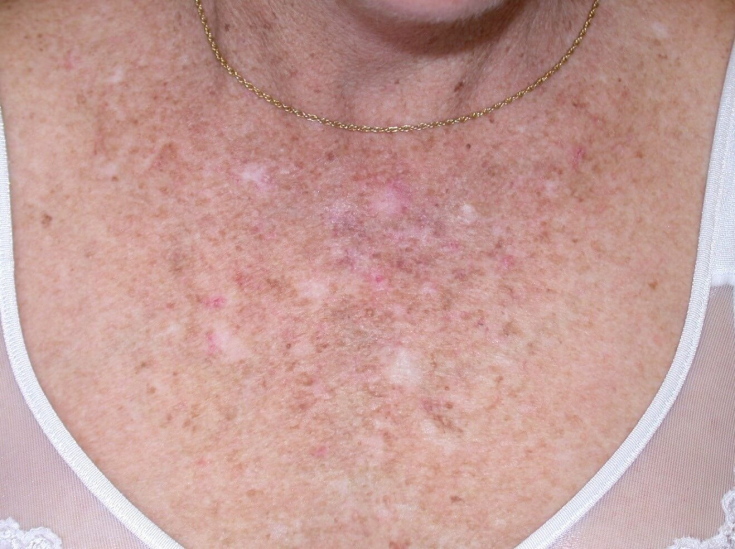With frequent and prolonged exposure of exposed skin to sunlight, actinic keratosis, senile or solar keratosis.
In the previous article, we looked at the causes, main symptoms and varieties of actinic keratosis.
Read more on estet-portal.com basic diagnostics and treatment methods, as well as medicinal drugs that are used to treat solar keratosis.
Also learn why it is dangerous to over-tan your skin and what preventive measures are in place to prevent actinic keratosis and its complications.
- Diagnosis and possible complications of actinic keratosis
- The main methods of treatment of senile keratosis
- What drugs are used to treat actinic keratosis
- Prognosis and prevention measures for actinic keratosisa
Diagnosis and possible complications of actinic keratosis
Progression of the skin lesion in actinic keratosis may develop from changes in the lower dermis.
The process is then regarded as squamous cell carcinoma, a type of skin cancer.
The larger, harder, and darker lesions are the most likely to develop into skin cancer.
When making a diagnosis, a specialist makes a differential diagnosis with diseases that are similar in appearance and clinical course.
These include psoriasis and skin cancer. This requires a skin biopsy.
You will also require skin biopsy to look for lesions that have reappeared after treatment for actinic keratosis and are not treatable.
Why hyperpigmentation gets worse and how to avoid it
The main methods of treatment of senile keratosis
The scheme and method of treatment of actinic keratosis is selected by the dermatologist individually, based on the location of the focus, the number of lesions, symptoms and the general health of the patient.

Let's look at several treatments for actinic keratosis:
- Cryotherapy.
This treatment is used when there is a small amount of lesion.
For the procedure, a cold substance is used - liquid nitrogen, which freezes and kills the cells in the lesion.
Drugs may be used before cryotherapy to improve the picture and shrink lesions.
- Electrodesiccation and scraping.
In this method, the cells in the lesion keratosis are dried with an electric current, then they are cleaned using a curette.
This procedure is performed under local anesthesia and is not suitable for large or large lesions.
Also applies:
- with a sharp blade in the operating room; laser therapy;
- chemical peel;
- dermabrasion
- ia.
Facebook! What drugs are used to treat actinic keratosis
In addition to instrumental methods of treatment, various medicinal substances are used, both separately and together or before the necessary treatment method.
1. Imiquimod is atopical drug that is an immune response modifier. This type of drug acts on the immune system, stimulating it to synthesize substances that fight cancer cells.
The medicine is applied topically. Apply to the skin 2 times a day for 4 months.
This remedy is widely used to treat large areas of skin lesions in actinic keratosis.
2. 5-fluorouracilis a drug from the group of antimetabolites, a pyramidin antagonist. Has an antitumor effect. Cream formulation, applied topically.
The treatment is also long lasting and is also effective for treating patients with large areas of skin damage.
3. Ingenol mebutateis a drug for the treatment of actinic keratosis. Acts locally, causes an inflammatory reaction and kills skin cells where it is applied. The duration and frequency of application is determined by the doctor individually, depending on the damage.
4.Other medicines may be used, eg NSAIDs. There is also
photodynamic therapywhich uses light-sensitive drugs. This drug, when applied to the skin
is absorbed by diseased and atypical cellsmore than normal skin cells. Next, the skin is exposed to light of a certain color, which activates the drug, and it acts by destroying abnormal cells.
Photodynamic therapy is used to treat many large lesions
Skin problems due to sun exposure Prognosis and prevention measures for actinic keratosis
To prevent the development of actinic keratosis, it is important to use
sunscreens withSPF of at least 15. The cream must be applied half an hour before sun exposure and every 2 hours during exposure.
It is important to wear a hat and light clothing in summer to protect exposed skin.
The best way to avoid developing actinic keratosis – avoid prolonged and excessive skin exposure to direct sunlight.
It is also important to know that there are times of day whenthe sun is most active
. This time is from
10.00 to 16.00,so, if possible, you should not stay under the sun for a long time, especially children. The development of actinic keratosis is an indicator of serious damage to the skin from ultraviolet radiation.
Patients who develop actinic keratosis are more likely to eliminate the risk of developing skin cancer by using drugs to treat the process.
But, ifleft untreated
, keratosis with a high probability may turn into cancer of the skin. After the treatment of actinic keratosis, the patient remains registered with a dermatologist and must be examined annually for recurrence and signs of skin damage.
Causes of xerosis of the skin: why the skin becomes dry







Add a comment